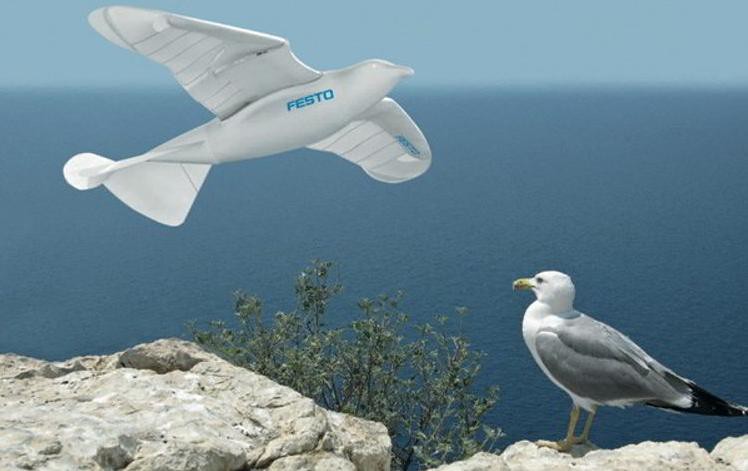SmartBird: the beautiful overlap of nature and technology

The robot, SmartBird, superimposed on a photograph of a herring gull, Larus argentatus, which inspired its creation. [NOTE: the pictured bird actually is a California gull, Larus californicus.]
Image: courtesy of Festo.
This robot is truly a thing of beauty.
One of the oldest dreams of mankind is to fly like a bird. Many, from Leonardo da Vinci to contemporary research teams, tried to decipher the flight of birds well enough to recreate it. Finally in 2011, the engineers at the German technology company, Festo, developed SmartBird, an avian robot that can take off and fly through the air by simply flapping its wings. In this video, Markus Fischer, Festo's head of corporate design, shows a live audience what SmartBird can do:
As the video mentioned, SmartBird was inspired by the herring gull, Larus argentatus. It's a bit larger than this gull species, with a two-metre wingspan and a carbon-fiber "skeleton" that weighs 450 grams (a bit more less than one pound). Like live birds, SmartBird's "torso" can flex, providing directional control. But unlike live birds, SmartBird's movements can be radio-controlled and monitored from afar.
But the most interesting thing (to my eyes) is how its wings move: as you'd expect, the wings move up and down -- generating lift -- but the wings also twist and flex in flight like those of a real bird. This torsion keeps the wing's leading edge pointed upwards during the upward stroke, so that the wing adopts a positive angle of attack. This smooth sequence of wing movements generates thrust.
This (soundless) video gives you a closer look at how SmartBird's wings work:
The tail of SmartBird functions as both a pitch elevator and a yaw rudder, producing lift whilst also aiding in turning.
What is the point of spending lots of money and time to develop a robotic gull when there are plenty of live gulls flying around most car parks and rubbish tips?
The focus of this research is to learn how to maximise energy-efficiency and conservation of resources.
"We learned from the birds how to move the wings, but also the need to be very energy efficient", says Mr Fischer.
SmartBird technology is providing key innovations and fresh insights that can optimise hybrid drive technology. For example, the minimal use of materials and its extremely lightweight construction are already improving efficiency in resource and energy consumption.
Mr Fischer is Festo's head of corporate design. He established the Bionic Learning Network, which developed SmartBird, in 2006.
Read a little more about SmartBird, or you can download the longer and more detailed PDF about SmartBird.
You can find Festo on twitter @didactic.
.
email: grrlscientist@gmail.com
twitter: @GrrlScientist
Source: http://www.guardian.co.uk/science/punctuated-equilibrium/2011/jul/26/1
Bank of England Argentina Dmitry Medvedev Alex Reid Top 10s Frank Lampard
No comments:
Post a Comment